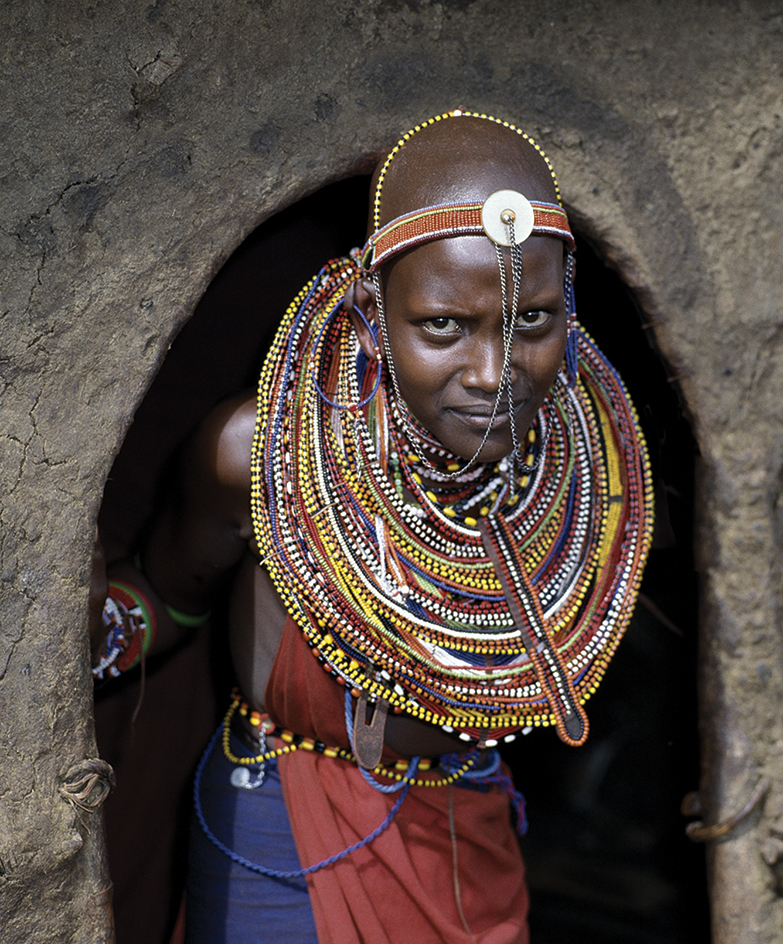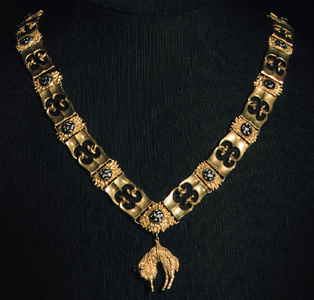Jewelry refers to the ornaments people wear. The most common types are bracelets, brooches, earrings, necklaces, and rings. Jewelry has been chiefly used for personal decoration. But it has also been worn for religious or magical purposes, or as a symbol of wealth or status. Most fine jewelry consists of precious metals and gems created in artistic designs. Gold is the chief metal used, but silver and platinum are also widely used.

Early jewelry.
Prehistoric jewelry consisted largely of crude necklaces and bracelets. They were made of leather or reeds strung with pebbles, berries, feathers, shells, or animal bones. People used decorative thorns or sharp bones to hold clothing together. Eventually, people pierced their ears, lips, and noses to wear such objects. People wore jewelry as part of religious ceremonies or to show rank. They believed certain jewelry could prevent sickness and protect them from bad luck.
Gradually, people learned to make jewelry from ivory, wood, and metal. As early as 3500 B.C., craftworkers discovered that gold heated with fire could be pounded into thin sheets and then shaped. Silver, copper, and bronze were also used.
By the late 2000’s B.C., Egyptians were using gemstones in such jewelry as bracelets, brooches, headdresses, pendants, and rings. They believed that gems had magical powers and wore them for good luck.
The ancient Egyptians made jewelry from a variety of gemstones as well as from glass, faience, and enamel. They wore beaded collars, which covered the shoulders and chest; breast ornaments called pectorals; and crownlike diadems. Egyptians also wore bracelets, anklets, earrings, and rings. The Egyptians included jewelry in tombs because they believed it would be useful in the afterlife.
The Greeks valued fine metalwork in their jewelry and rarely used inlaid gems. Greek jewelry featured beautiful filigree, a lacelike decoration made by twisting fine wires of gold or silver into patterns.
Unlike the Greeks, the Romans often used gems in their jewelry. They used gold settings but placed greater emphasis on precious stones. They especially wore gems in rings. The Romans were probably the first to use rings as a symbol of engagement.
European jewelry.
During the early Middle Ages, beginning in the A.D. 700’s, the wearing of jewelry was almost entirely restricted to royalty and members of the royal courts. Between 1200 and 1400, a prosperous middle class rose. This class began to acquire jewelry, wearing it as a sign of social status. Gold was still the most prominent precious metal, though some bronze and silver was also used. Jewelry most often took the form of brooches, buckles, head ornaments, and rings.

Precious stones were very fashionable in the 1500’s. Jewelers often set gems in heavy pendants that were fastened to the sleeve, as well as on a chain around the neck. Women wove long strands of pearls and other gems into their hairdos. The first watches were made in the early 1500’s. People wore them in pendants and miniature cases. During the 1600’s and 1700’s, diamonds became popular as a result of advances in gem cutting.
Oriental jewelry.
Jewelry became popular in China during the Song dynasty (960-1279). The Chinese favored silver, enamel, feathers, and jade. Jade was often carved or polished and combined with metal. Chinese jewelry was very delicate and elaborate and often took the form of ornate headdresses.
Japanese jewelry was similar to Chinese jewelry. However, the Japanese first used jeweled objects to decorate swords and ceremonial objects. Later, they began to wear jewelry as a personal adornment. Japanese jewelry consisted primarily of earrings, hair ornaments, necklaces, pendants, and rings.
Pre-Columbian jewelry.
American Indian art created before A.D. 1500 is called pre-Columbian because it was produced before Christopher Columbus arrived in the New World in 1492. During pre-Columbian times, the Indians of the Inca empire inhabited large parts of South America. The Inca cultures were highly skilled at working with metals, especially gold and silver. Most of the Inca jewelry was melted down by Spanish conquerors in the 1500’s. However, a few pieces survived. These include large round rings, armbands, headdresses, masks, ornate necklaces, and earrings.
The Maya Indians of southern Mexico and Central America made jewelry of gold, jade, and other materials in the region. The Maya created bracelets, large necklaces, and ceremonial masks with geometric designs.
Modern jewelry.
Most jewelry today is machine made. However, many expensive pieces are created by hand. Fine American Indian jewelry is still handcrafted. Many people make jewelry as a hobby. Costume jewelry, which is inexpensive mass-produced jewelry, is also popular.

